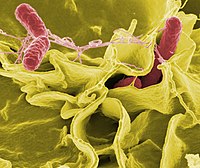
Photo from wikipedia
Background Salmonella enterica serovar Enteritidis ( S . Enteritidis) is one of the most common serovars, associated with human salmonellosis. The food-borne outbreak of this bacterium is mainly related to… Click to show full abstract
Background Salmonella enterica serovar Enteritidis ( S . Enteritidis) is one of the most common serovars, associated with human salmonellosis. The food-borne outbreak of this bacterium is mainly related to the consumption of contaminated poultry meat and poultry products, including eggs. Therefore, rapid and accurate detection, besides investigation of virulence characteristics and antimicrobial resistance profiles of S . Enteritidis in poultry and poultry egg samples is essential. A total of 3125 samples (2250 poultry and 875 poultry egg samples), sent to the administrative centers of veterinary microbiology laboratories in six provinces of Iran, were examined for Salmonella contamination, according to the ISO 6579 guideline. Next, duplex PCR was conducted on 250 presumptive Salmonella isolates to detect invA gene for identification of the genus Salmonella and sdf gene for identification of S . Enteritidis. Subsequently, the S. Enteritidis isolates were examined for detection of important virulence genes ( pagC , cdtB , msgA , spaN , tolC , lpfC , and spvC ) and determination of antibiotic resistance patterns against nalidixic acid, trimethoprim-sulfamethoxazole, cephalothin, ceftazidime, colistin sulfate, and kanamycin by the disk diffusion method. Results Overall, 8.7 and 2.3% of poultry samples and 6.3 and 1.3% of eggs were contaminated with Salmonella species and S. Enteritidis, respectively. The invA and msgA genes (100%) and cdtB gene (6.3%) had the highest and the lowest prevalence rates in S . Enteritidis isolates. The spvC gene, which is mainly located on the Salmonella virulence plasmid, was detected in 50.8% of S . Enteritidis isolates. The S . Enteritidis isolates showed the highest and the lowest resistance to nalidixic acid (87.3%) and ceftazidime (11.1%), respectively. Unfortunately, 27.0% of S . Enteritidis isolates were multidrug-resistant (MDR). Conclusion The rate of contamination with Salmonella in the poultry and egg samples, besides the presence of antimicrobial resistant and MDR Salmonella isolates harboring the virulence genes in these samples, could significantly affect food safety and subsequently, human health. Therefore, continuous monitoring of animal-source foods, enhancement of poultry farm control measures, and limiting the use of antibiotics for prophylactic purposes in food producing animals, are essential for reducing the zoonotic risk of this foodborne pathogen for consumers and also choosing effective antibiotics for the treatment of salmonellosis.
Journal Title: BMC Veterinary Research
Year Published: 2021
Link to full text (if available)
Share on Social Media: Sign Up to like & get
recommendations!